
The Lund 1 Runestone, designated as DR 314 in the Rundata catalog, is a Viking Age memorial runestone originally located on the grounds of the All Saints Church in Lund, Scania, Sweden.

The Lund 1 Runestone, designated as DR 314 in the Rundata catalog, is a Viking Age memorial runestone originally located on the grounds of the All Saints Church in Lund, Scania, Sweden.
The Lund 1 Runestone is a granite stone pillar nearly four meters in height that has inscriptions carved on its four sides. There are runic inscriptions carved on sides A and B of the stone, images of two animals identified as wolves and a man's mask on side C, and the mask of a lion face on side D. The runic inscriptions are classified as being carved in runestone style RAK, which is the classification of the oldest inscriptions. This is the runestone style classification of inscriptions where the ends of the text bands are straight and there are no attached serpent or animal heads. The inscription, which has a Danish Rundata catalog number because Scania was part of the historical Denmark during the Viking Age, is dated as being carved after the Jelling stones of Denmark.
The two wolves on Side C are apparently armed with a shield and sword strapped to their bodies. [1] The depiction of the wolves show a mane and pointed ears similar to that of the wolf on inscription DR 284 of the Hunnestad Monument and on the DR 271 in Tullstorp. [1] The man's mask between the two wolves is similar to those depicted on two other runestones in Scania, inscriptions DR 258 in Bösarp and DR 335 in Västra Strö. [2] The lion face mask on Side D is similar to that depicted on the inscription DR 66 from Denmark, which is also known as the Århus 4 image stone or the Mask Stone. [3] Other inscriptions with facial masks include DR 62 in Sjelle, DR 81 in Skern, the now-lost DR 286 in Hunnestad, Vg 106 in Lassegården, Sö 86 in Åby ägor, Sö 112 in Kolunda, Sö 167 in Landshammar, Sö 367 in Släbro, Nä 34 in Nasta, U 508 in Gillberga, U 670 in Rölunda, U 678 in Skokloster, U 824 in Örsundsbro, U 1034 in Tensta, and U 1150 in Björklinge, and on the Sjellebro Stone. [3]
The runic text states that the stone is a memorial raised by a man named Þorgísl in memory of his two brothers, Ólafr and Óttarr. The text refers to "stones" that were raised, so the original memorial consisted of at least one additional raised stone. [4] Ólafr and Óttarr are described as being landmennr góða, or "good landowners." A similar Old Norse phrase praising the deceased, landmanna beztr meaning "best of landholders," is present on the inscriptions on memorial runestones Sö 338 in Turinge and DR 133 in Skivum, Denmark. Landmennr is sometimes translated as "land-men." Some believe that the term land-men refers to a title that is something higher than a simple free farmer, such as a rich farmer or squire, [5] although there is dispute regarding this. [6]

The name of the father of the stones sponsor, Ásgeirr Bjôrn, has several name elements that were common at that time in Scandinavia. Ásgeirr means "Divine Spear" and contains a name element referring to the Æsir, the Norse pagan gods, while Bjôrn means "Bear." [8] Þorgísl also contains a god's name as an element and means "Thor's Hostage." [9]
The Lund 1 Runestone was discovered in the ruins of a monastery in 1682, [4] where it had apparently been re-used as material in the construction of that building. Before the historic significance of runestones was understood, they were often used as materials in the construction of roads, bridges, and buildings. The stone was found broken at two locations, but in 1868 it was repaired and raised at the Lundagård. [4] Since 1957 the runestone has been located in the entrance hall of the library at the Lund University. [4] Locally the runestone is referred to as the Lundastenen ("the Lund Stone") or the Lundagårdsstenen ("the Lundagård Stone").
| Wikimedia Commons has media related to Lundastenen 1 (DR 314) . |

A runestone is typically a raised stone with a runic inscription, but the term can also be applied to inscriptions on boulders and on bedrock. The tradition began in the 4th century and lasted into the 12th century, but most of the runestones date from the late Viking Age. Most runestones are located in Scandinavia, but there are also scattered runestones in locations that were visited by Norsemen during the Viking Age. Runestones are often memorials to dead men. Runestones were usually brightly coloured when erected, though this is no longer evident as the colour has worn off. Most runestones are found in present-day Sweden.
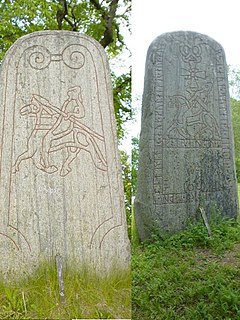
U 678 is the Rundata catalog number for a Viking Age image stone with a runic inscription located in Skokloster, Uppland, Sweden.
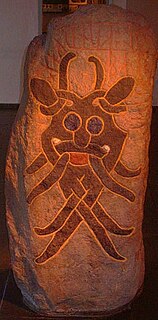
Danish Runic Inscription 66 or DR 66, also known as the Mask stone, is a granite Viking Age memorial runestone that was discovered in Aarhus, Denmark. The inscription features a facial mask and memorializes a man who died in a battle.
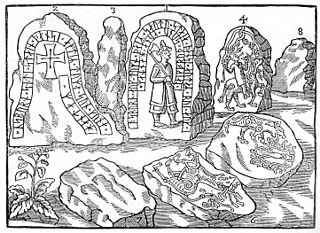
The Hunnestad Monument, listed as DR 282 through 286 in the Rundata catalog, was once located at Hunnestad at Marsvinsholm north-west of Ystad, Sweden. It was the largest and most famous of the Viking Age monuments in Scania, and in Denmark, only comparable to the Jelling stones. The monument was destroyed during the end of the 18th century by Eric Ruuth of Marsvinsholm, probably between 1782 and 1786 when the estate was undergoing sweeping modernization, though the monument survived long enough to be documented and depicted.

The Gardarike Runestones are runestones in Scandinavia that mention voyages to the East (Austr) or the Eastern route (Austrvegr), or to more specific eastern locations such as Garðaríki.
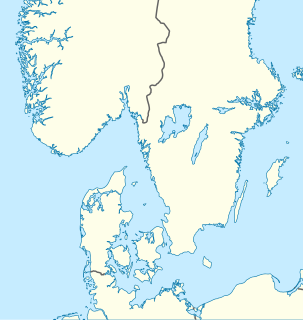
The Viking runestones are runestones that mention Scandinavians who participated in Viking expeditions. This article treats the runestone that refer to people who took part in voyages abroad, in western Europe, and stones that mention men who were Viking warriors and/or died while travelling in the West. However, it is likely that all of them do not mention men who took part in pillaging. The inscriptions were all engraved in Old Norse with the Younger Futhark. The runestones are unevenly distributed in Scandinavia: Denmark has 250 runestones, Norway has 50 while Iceland has none. Sweden have as many as between 1,700 and 2,500 depending on definition. The Swedish district of Uppland has the highest concentration with as many as 1,196 inscriptions in stone, whereas Södermanland is second with 391.

The Tullstorp Runestone is a Viking Age memorial runestone, listed as DR 271 in the Rundata catalog, that is located in Tullstorp, which is about twenty kilometers east of Trelleborg, Skåne County, Sweden, and in the historic province of Scania.

Uppland Runic Inscription 1034 or U 1034 is the Rundata catalog number for a runic inscription on a runestone located at the Tensta Church, which is three kilometers northwest of Vattholma, Uppsala County, Sweden, and in the historic province of Uppland, that was carved in the late 11th or early 12th century. While the tradition of carving inscriptions into boulders began in the 4th century and lasted into the 12th century, most runestones date from the late Viking Age.

This runic inscription, designated as U 448 in the Rundata catalog, is on a Viking Age memorial runestone located in Harg, which is about 4 kilometers north of Märsta, Stockholm County, Sweden, which was in the historic province of Uppland.
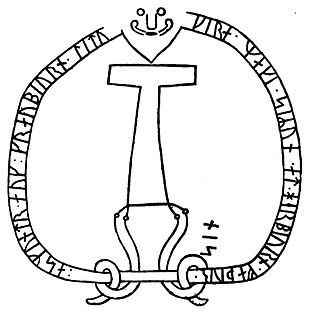
Sö 86 is the Rundata catalog number for a Viking Age memorial runic inscription located in Åby, which is about one kilometer north of Ålberga, Södermanland County, Sweden, and in the historic province of Södermanland. The inscription features a depiction of the hammer of the Norse pagan god Thor named Mjöllnir and a facial mask.

The Holmby Runestone, listed as DR 328 in the Rundata catalog, is a Viking Age memorial runestone with an image of a ship that is located in Holmby, which is about 2 kilometers southeast of Flyinge, Scania, Sweden.
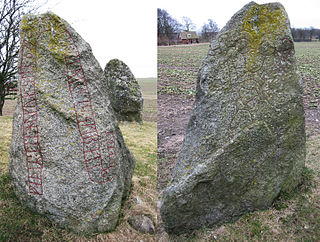
The Västra Strö 2 Runestone, listed as DR 335 in the Rundata catalog, is a Viking Age memorial runestone located at the Västra Strö Monument, which is at a church that is about four kilometers northwest of Eslöv, Skåne County, Sweden.
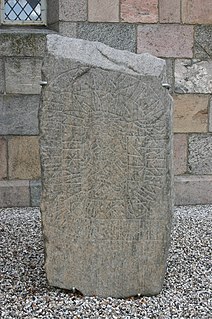
The Skern Runestone, designated as Danish Runic Inscription 81 or DR 81 in the Rundata catalog, is a Viking Age memorial runestone located in the small village of Skjern, Denmark between Viborg and Randers. The stone features a facial mask and a runic inscription which ends in a curse. A fragment of a second runestone designated as DR 80 was also found in Skjern.

The Bjäresjö Runestones are three Viking Age memorial runestones originally located adjacent to Bjäresjö Church in Bjäresjö, which is about 3 kilometers northwest of Ystad, Skåne County, Sweden. Two of the stones were discovered near the church, and two of the stones have been moved to other nearby locations. Although these three stones are located in Sweden, they have been given Danish designations because Scania was part of the historic Denmark.

The Fölene Runestones are two Viking Age memorial runestones which are located near the church in Fölene, which is about two kilometers west of Herrljunga, Västra Götaland County, Sweden, which was in the historic province of Västergötland. The stones are memorials to two men who were described as holding the title drengr.

The Sövestad Runestones consist of a Viking Age image stone and memorial runestone found near Krageholm Castle, which is about two kilometers west of Sövestad, Skåne County, Sweden.

Småland Runic Inscription 39 or Sm 39 is the Rundata catalog listing for a Viking Age memorial runestone that is located in Ryssby, Kronoberg County, Sweden, which is in the historic province of Småland.

The Västra Nöbbelöv Runestone, listed as DR 278 in the Rundata catalog, is a Viking Age memorial runestone located in Västra Nöbbelöv, which is about 3 kilometers east of Skivarp, Skåne County, Sweden, and was in the historic province of Scania.
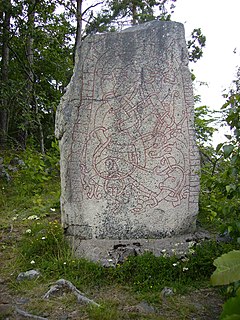
The Nasta Runestone, listed as Nä 34 in the Rundata catalog, is a Viking Age memorial runestone located in Nasta, which is 3 kilometers northwest of Glanshammar, Örebro County, Sweden, which was in the historic province of Närke.

The Ålum Runestones are four Viking Age memorial runestones which are located at the church in Ålum, which is 9 km west of Randers, Denmark. One of the stones refers to a man with the title drengr and two of the other stones were raised by the same family.